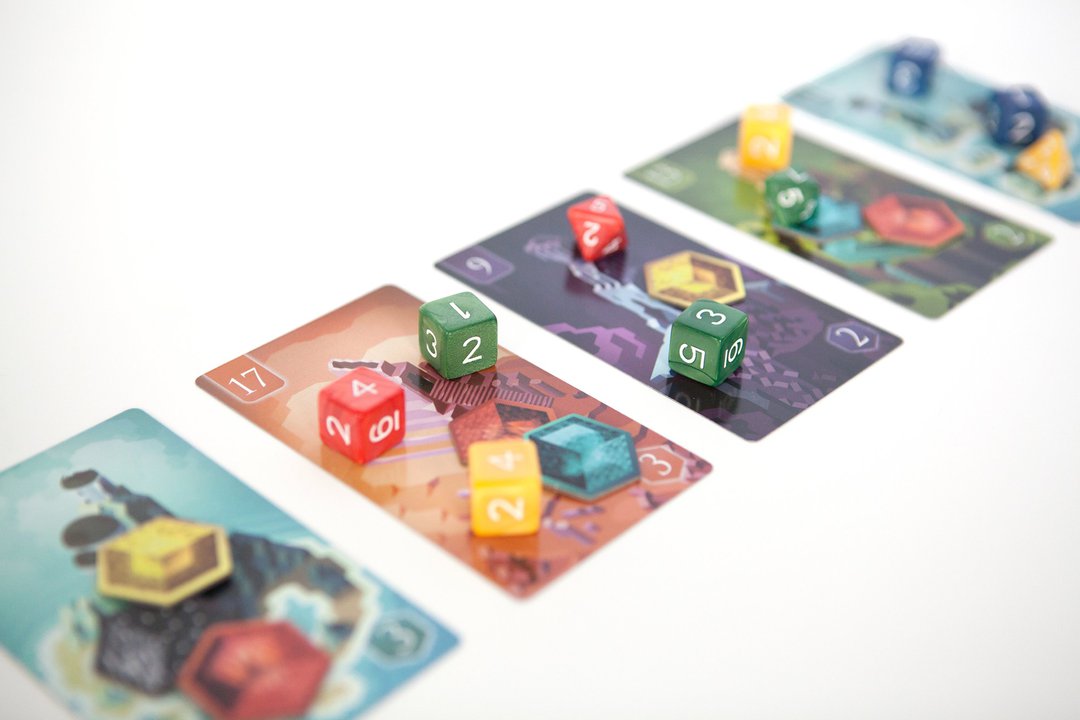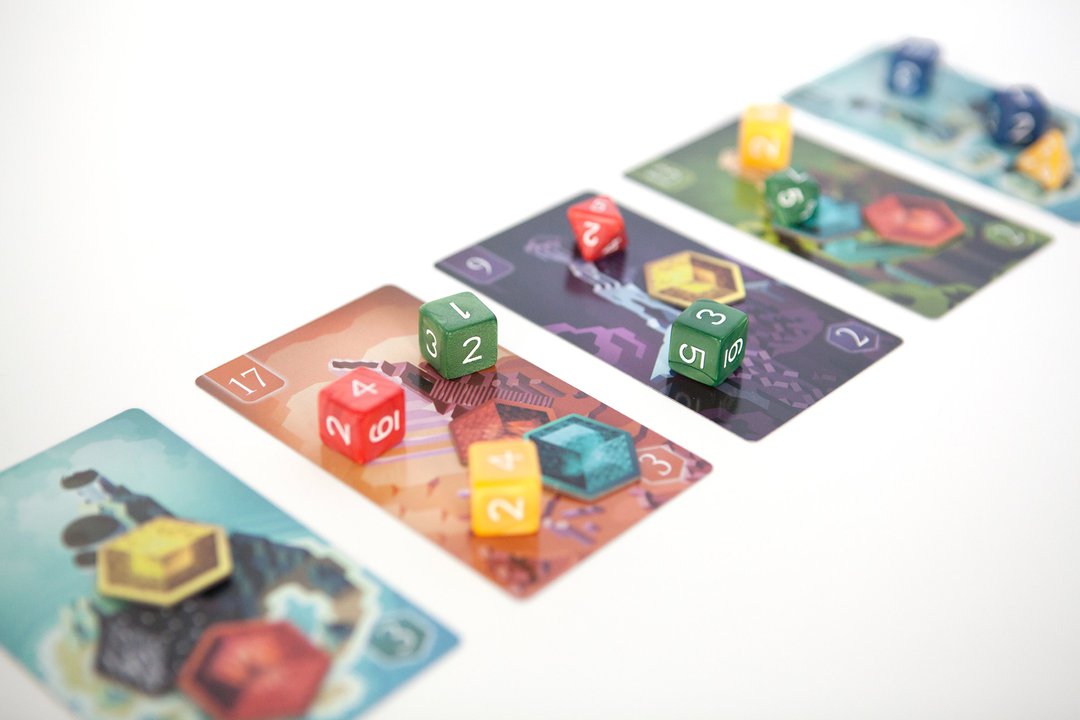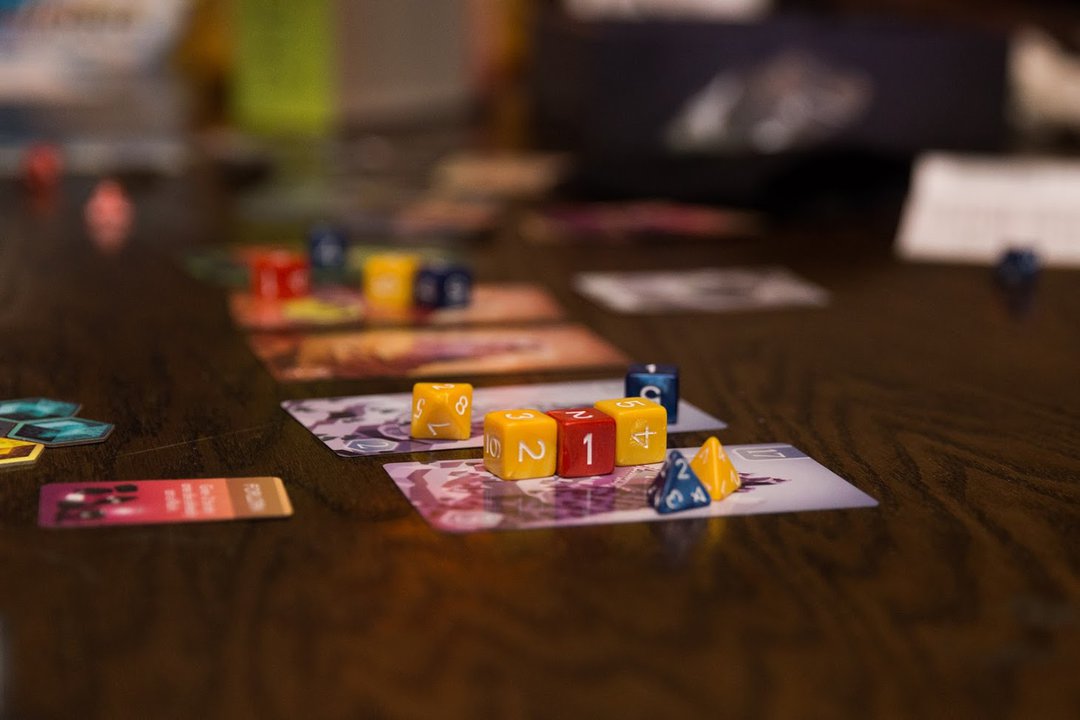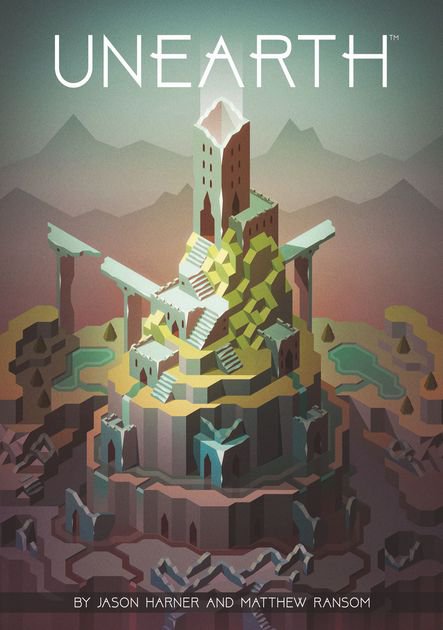Unearth
Publisher: Brotherwise Games
Format: Card Game
Number of Players: 2-4 Players
Play Time: 30-60 Minutes
Price: $34.95
Copy Provided By Publisher
2017
Unearth is a game I wasn’t expecting out of Brotherwise Games. Their original game, Boss Monster, was a fun, tongue-in-cheek nod to old 8 bit video games. In comparison, Unearth tries to build something new, both mechanically and aesthetically. It also does something that would have been considered verboten a year or two ago: it attempts to be a serious game that plays with dice.
I am so glad that they chose to experiment with Unearth. As I open up this game to play for the dozenth time, I am still excited to play it again.
The Concept: Digging Up Ruins And Wonders
Unearth uses a minimalist art style to convey a world that’s in pieces. Long ago, there were great empires that were destroyed; now, each player represents a small clan or tribe moving around the world, trying to bring glory back to their people. Your turns are your people wandering the world, digging up what was lost long ago to find the way forward. It's a simple - and compelling - premise.

The slogan “Reclaim, Rebuild, Remember” is catchy, and the art style helps to drag you in. While the theme isn’t the strongest I’ve seen, it’s there enough in the art and delver card descriptions that it does feel as though you are attempting to build back up from nothing. The art is wonderful, crafted in a style that’s more often seen in video games such as Necropolis than board games.
The Gameplay: Finding Balance In Dice Rolls
A player's turn is a simple affair: use as many cards as you like from your hand, then roll one of your dice in an attempt to score one of the ruin cards that is on the table. The ruin you have chosen to roll on has the die set down on top of it, and if the numbers of all the die equals or is greater than the claim value on it, the claim resolves, and goes to the person with the highest die face on it at that time. It's all about seeing what is available on the board, and choosing what is the smartest bet you can make.
The basic concept is extremely straight forward, but Unearth does a great job of complicating the typical ‘highest roll wins’ mechanic. First off, each player has five dice total to use: a D4, three D6, and a D8. Obviously, the D8 is your chance to go big on a ruin to earn it, but there’s a reason why the D4 is maybe my favorite die in the game, and that is the chance to earn stones.

This is what your personal play area might look like: you build small sections to earn particular wonders, and earn advantages.
Every time you roll a 1, 2, or 3, you have a chance to earn a stone that’s on that particular ruin card. Each ruin starts with several, and as you collect different colored stones, you arrange them into a hexagon with an open middle. Once you have six stones, you can collect a wonder, which scores you points. Every game also has randomly dealt special wonders that can also give you advantages, such as rerolls or extra points for certain choices you make. You have to collect stones in a particular color order to make this happen however, and it’s a fun way to create a secondary game inside the main objective.
The game ends once the ruins pile is depleted. You total up how many ruins you have earned, and collecting multiples of the same type is a huge advantage points wise, making you try and focus throughout the game. You also total up points from your wonders, and decide on the winner then.
The Good: A Great Blend of Mechanics
One of the great things Unearth does is how much it rewards effort. Rolling high gives you a chance to win the ruin itself, but getting a low roll helps you build towards wonders that might help swing the game in your favor. Honestly, while collecting ruins is the main point of the game, it’s almost too easy to get distracted with wanting to collect particular stones to make your little network of wonders. It’s a fun element that elevates Unearth from something that would feel like a luck-fest into a game with real strategy.
Another layer is added when you add in the delver cards; small cards you hold in your hand and play to help modify your role, or dice that have already been played. It feels great taking a roll of a 4 and twisting it into a 3 to get that stone you needed to complete a set, or being able to reroll a ton of dice for free. While you only start the game with three cards, you get more cards every time you fail to win a ruin, and have leftover dice given back to you. It’s another way that Unearth makes sure there isn’t a runaway winner due to just one lucky roll.

The ease of play and the quick rounds make it a great fit for casual meet ups, or play in public like bars. Picture credit to Elle Riccardi.
This game is fun, and its fast. It strikes a mix between being a popcorn game and making players really scratch their head choosing their next play. When the box says games are 30-60 minutes long, it nails that estimate very well, with most of my games of 3-4 players coming in at 45 minutes, and that is with teaching the game. The art captures people’s attention, and the rush of rolling die adds some excitement to the game that some euros can’t quite capture.
The Nitpicks: A Pretty Dice Game Is Still A Dice Game
The biggest issue I’ve had trying to teach this game is explaining how it all comes together. It takes a moment for people to understand that rolling high can score you the ruins you want for points, while low rolls can still net you some effects for the way forward. I have had several players at our local bar night get near the game and then feel jilted by how the point score break down. Fortunately, the games of Unearth are on the short side, and that feeling goes away after seeing a full game played through.
The one thing to really keep in mind if you are thinking about picking up Unearth: it’s a dice game. For many right now in the gaming community that’s either a big attractor or an immediate thumbs down. I appreciate how well Unearth lets you hedge your bets and play skillfully, but there are still turns where luck is in your favor, and where luck decides it hates you.
Unearth Is A Great Game That Challenges and Charms
Unearth is a game that presents a fun puzzle; it has enough depth and mechanics to grab and hold your interest, while also being light and short enough to be used as a great filler game. It’s a blend of simple and complex, which makes it a perfect entry game for many into the board game world, but for those that already have many favorites, it might not capture their attention in the same way.
With that being said, I can safely say Unearth is on my short list of games I bring with me to events. Unearth is a testament to how games with dice are finding new life and new ways to have fun. Sitting at a bar, this game has enough style to make people stop and take notice, and plenty of mechanics to become engaging. It’s a perfect entry for gamers who have enjoyed long euro style games to try and dip their toes back into dice games, and I can imagine that for parents that have kids hitting 10+, this would be a great gift.

In my dozen-plus games, I have heard a lot of laughter around the table playing Unearth. The excitement to collecting sets, the tension of leaving pivotal moments up to luck, and the strategy of building a small little world of your own. It’s a mixture that I never would have thought of, but it works beautifully. If you get a chance, sit down and give Unearth a try; it’s a great example of mixing game elements to create something new.